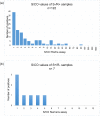Contamination with HIV antibody may be responsible for false positive results in specimens tested on automated platforms running HIV 4th generation assays in a region of high HIV prevalence
- PMID: 28759622
- PMCID: PMC5536287
- DOI: 10.1371/journal.pone.0182167
Contamination with HIV antibody may be responsible for false positive results in specimens tested on automated platforms running HIV 4th generation assays in a region of high HIV prevalence
Abstract
Introduction: In South Africa where the prevalence of HIV infection is very high, 4th generation HIV antibody/p24 antigen combo immunoassays are the tests of choice for laboratory based screening. Testing is usually performed in clinical pathology laboratories on automated analysers. To investigate the cause of false positive results on 4th generation HIV testing platforms in public sector laboratories, the performance of two automated platforms was compared in a clinical pathology setting, firstly on routine diagnostic specimens and secondly on known sero-negative samples.
Methods: Firstly, 1181 routine diagnostic specimens were sequentially tested on Siemens and Roche automated 4th generation platforms. HIV viral load, western blot and follow up testing were used to determine the true status of inconclusive specimens. Subsequently, known HIV seronegative samples from a single donor were repeatedly tested on both platforms and an analyser was tested for surface contamination with HIV positive serum to identify how suspected specimen contamination could be occurring.
Results: Serial testing of diagnostic specimens yielded 163 weakly positive or discordant results. Only 3 of 163 were conclusively shown to indicate true HIV infection. Specimen contamination with HIV antibody was suspected, based on the following evidence: the proportion of positive specimens increased on repeated passage through the analysers; viral loads were low or undetectable and western blots negative or indeterminate on problem specimens; screen negative, 2nd test positive specimens tested positive when reanalysed on the screening assay; follow up specimens (where available) were negative. Similarly, an increasing number of known negative specimens became (repeatedly) sero-positive on serial passage through one of the analysers. Internal and external analyser surfaces were contaminated with HIV serum, evidence that sample splashes occur during testing.
Conclusions: Due to the extreme sensitivity of these assays, contamination with minute amounts of HIV antibody can cause a negative sample to test positive. Better contamination control measures are needed on analysers used in clinical pathology environments, especially in regions where HIV sero-prevalence is high.
Conflict of interest statement
Figures




Similar articles
-
HIV false positive screening serology due to sample contamination reduced by a dedicated sample and platform in a high prevalence environment.PLoS One. 2021 Jan 11;16(1):e0245189. doi: 10.1371/journal.pone.0245189. eCollection 2021. PLoS One. 2021. PMID: 33428663 Free PMC article.
-
Rapid and simple screening and supplemental testing for HIV-1 and HIV-2 infections in west Africa.AIDS. 1993 Jun;7(6):883-5. doi: 10.1097/00002030-199306000-00019. AIDS. 1993. PMID: 8395857
-
Performance comparison of the 4th generation Bio-Rad Laboratories GS HIV Combo Ag/Ab EIA on the EVOLIS™ automated system versus Abbott ARCHITECT HIV Ag/Ab Combo, Ortho Anti-HIV 1+2 EIA on Vitros ECi and Siemens HIV-1/O/2 enhanced on Advia Centaur.J Clin Virol. 2013 Dec;58 Suppl 1:e79-84. doi: 10.1016/j.jcv.2013.08.009. J Clin Virol. 2013. PMID: 24342482
-
Comparison of Detection Limits of Fourth- and Fifth-Generation Combination HIV Antigen-Antibody, p24 Antigen, and Viral Load Assays on Diverse HIV Isolates.J Clin Microbiol. 2018 Jul 26;56(8):e02045-17. doi: 10.1128/JCM.02045-17. Print 2018 Aug. J Clin Microbiol. 2018. PMID: 29793968 Free PMC article.
-
Screening in Primary Care Settings for Illicit Drug Use: Assessment of Screening Instruments: A Supplemental Evidence Update for the U.S. Preventive Services Task Force [Internet].Rockville (MD): Agency for Healthcare Research and Quality (US); 2008 Jan. Report No.: 08-05108-EF-2. Rockville (MD): Agency for Healthcare Research and Quality (US); 2008 Jan. Report No.: 08-05108-EF-2. PMID: 20722154 Free Books & Documents. Review.
Cited by
-
BioRad BioPlex® HIV Ag-Ab assay: Incidence of false positivity in a low-prevalence population and its effects on the current HIV testing algorithm.J Clin Virol. 2019 Jul;116:1-3. doi: 10.1016/j.jcv.2019.04.002. Epub 2019 Apr 6. J Clin Virol. 2019. PMID: 30981082 Free PMC article.
-
High positive HIV serology results can still be false positive.IDCases. 2020 May 28;21:e00849. doi: 10.1016/j.idcr.2020.e00849. eCollection 2020. IDCases. 2020. PMID: 32514397 Free PMC article.
-
HIV false positive screening serology due to sample contamination reduced by a dedicated sample and platform in a high prevalence environment.PLoS One. 2021 Jan 11;16(1):e0245189. doi: 10.1371/journal.pone.0245189. eCollection 2021. PLoS One. 2021. PMID: 33428663 Free PMC article.
-
Increase in False-Positive Fourth-Generation Human Immunodeficiency Virus Tests in Patients With Coronavirus Disease 2019.Clin Infect Dis. 2023 Aug 22;77(4):615-619. doi: 10.1093/cid/ciad264. Clin Infect Dis. 2023. PMID: 37158382 Free PMC article.
References
-
- Simbayi, L. C., Shisana, O., Rehle, T., Onoya, D., Jooste, S., Zungu, N., et al. South African National HIV Prevalence, Incidence and Behaviour Survey, 2012. 2014. Available from: http://www.hsrc.ac.za/en/research-data/view/6871 - PubMed
-
- Wolpaw BJ, Mathews C, Chopra M, Hardie D, de Azevedo V, Jennings K, et al. The failure of routine rapid HIV testing: a case study of improving low sensitivity in the field. BMC Health Serv Res [Internet]. 2010;10:73 Available from: http://www.pubmedcentral.nih.gov/articlerender.fcgi?artid=2851712&tool=p... doi: 10.1186/1472-6963-10-73 - DOI - PMC - PubMed
-
- Begg K, Young T, Stone P. Analysis of POCT / VCT performed at South African primary health care clinics. 2012;1–44. Avaiable from: http://www.sead.co.za/downloads/POCT-clinics-2011.pdf
-
- World Health Organization. Recommendations for the selection and use of HIV antibody tests. Wkly Epidemiol Rec. 1997;72(12):81–8. - PubMed
-
- Alexander TS. Human Immunodeficiency Virus Diagnostic Testing: 30 Years of Evolution. Clin Vaccine Immunol [Internet]. 2016;23(4):249–53. Available from: doi: http://cvi.asm.org/lookup/doi/10.1128/CVI.00053-16 - DOI - PMC - PubMed
MeSH terms
Substances
LinkOut - more resources
Full Text Sources
Other Literature Sources
Medical
Molecular Biology Databases

